
The Thomas Select School is a historic log building in rural Butler County, Ohio, United States. Constructed in 1810, the building has seen numerous uses, ranging from church to school to house. It has been named a historic site.

Stone Academy in Solon, Iowa is a public one-room schoolhouse believed to have been built in 1842, located about two miles north of Solon's town center along the west side of Iowa Highway 1, which was the Old Military Road linking Dubuque to Iowa City. It was formerly known as the Big Grove Township School #1. It is one of the oldest surviving school buildings in Iowa.
Little Red Schoolhouse may refer to:

Pleasant Valley School in Bellvue, Colorado is a one-room rural schoolhouse that was built in 1879. Its foundation and walls were built of sandstone from a nearby quarry. It has a front-gabled simple roof with wide overhanging eaves.
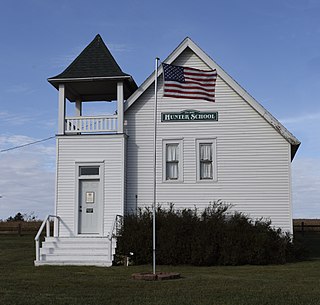
Hunter School is a historic building near Tabor, Iowa, United States. The one-room schoolhouse was built in 1901. The school was named for John H. Hunter, a farmer and landowner on whose property the original school was built in 1901. Its use as a schoolhouse came to an end in 1920 when it was consolidated into the Tabor School District. The building was used as a township meeting and a polling place until 1990. Since then it has been maintained as a historical landmark. The former schoolhouse is a frame structure built on a brick foundation, and consists of a 24-by-26-foot main block and an 8-foot (2.4 m) square bell tower-entrance. While the schoolhouse overall follows a basic plan for a one-room schoolhouse, it departs from that plan with the asymmetrically placed corner tower. It was added to the National Register of Historic Places in 2007.
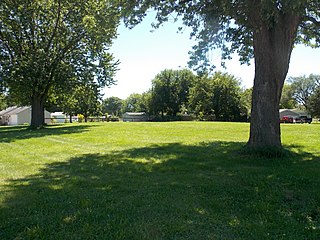
The Gilruth Schoolhouse was a historic building located in Davenport, Iowa, United States. The one-room school was built in 1871 by the Rev. James Gilruth, who was a Methodist minister, wrestler, and axe thrower. The school was started as a subscription school to educate Gilruth's children, grandchildren, and neighbors. This was a common type of school in Iowa before education was publicly funded. In such a system, parents generally organized and financially supported the school, hired the teacher, and devised the curriculum.
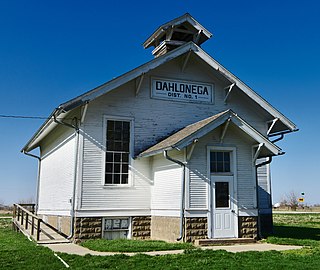
Dahlonega School No. 1 is an historic school building located near Ottumwa, Iowa, United States. It is located in the center of the unincorporated community of Dahlonega. The building was completed in 1921 and served as a school building until 1959. It served as a voting place for the township until 1986. The one-room schoolhouse measures 1,100 square feet (100 m2). The property was listed on the National Register of Historic Places in 2000.

Forest Grove School No. 5 is an historic building located near Bettendorf, Iowa, United States. It was listed on the National Register of Historic Places in 2013.

Walnut Grove School is a historic one-room schoolhouse located southwest of Osage in rural Mitchell County, Iowa, United States. It was in operation from 1857 to 1946, and it educated anywhere from five to thirty-three student at a time. The frame structure built on a limestone foundation was constructed in 1873 on the same site as the building it replaced. A bell tower with a cast iron bell is located on the gable roof above the main entrance. Its property is on the edge of a timber along Rock Creek. In 1911 there were 88 one-room school houses in Mitchell County. This is the only one that is unaltered and in its original location. The area was settled by Norwegian pioneers in 1853. They named their small town Meroa, which has been reduced to his old schoolhouse, a Lutheran church, a cemetery, and a few houses. The building was listed on the National Register of Historic Places in 2002.

Central School, also known as Hickory Grove School, is a historic one-room schoolhouse located northeast of Canton, Iowa, United States. It is one of over 217 limestone structures in Jackson County from the mid-19th century, of which 12 are school buildings. This school building was built in 1868, possibly by G.W. Kelsall or Issac Wilmer McCullogh, who were local stonemasons. The stone blocks that were used in the construction of this rectangular structure vary somewhat in shape and size, and they were laid in courses. What is unusual about the stone used here is that they are long and narrow, compared to the other buildings. The stones used at the corners are somewhat larger. The window sills and lintels are dressed stone. The stone used for this building was quarried about a mile north of here. A name and date stone are located on the east gable, above the door. The building was listed on the National Register of Historic Places in 1992.

Canton School is a historic one-room schoolhouse located in the unincorporated community of Canton, Iowa, United States. This school building was built in 1877 of locally quarried, roughly-dressed limestone, laid in a random ashlar pattern. The main facade, however, is faced with concrete brick that is original to the structure. What is unusual about this building is its decorative elements, as most one-room schoolhouses built in Iowa were plain. The eaves and the two-stage wooden bell tower are edged with rather delicate wooden trim, and the windows are capped with concrete keystone hoods. The use of concrete is rather sophisticated for a building in the vernacular-folk architectural style in stone. The building served as a school until 1966 when the area's school districts were reorganized. It served as a church until 1968, and it is now surrounded by a park.

The Upper Stone Schoolhouse, also known as the Scott House, is a historic One-room schoolhouse located east of Vinton, Iowa, United States. Built in 1875, this is an unusual example of a stone one-room school. There was only one other built in Benton County, about 2 miles (3.2 km) to the southeast. The stone schoolhouse was replaced by a wood frame building to the south sometime between 1905 and 1910 to accommodate the large number of students. It served eight rural sections of farmland from the time. The Scott family, who owned the adjacent farmland, bought the stone school building after it closed and converted it into a house. It was listed on the National Register of Historic Places in 1983.

Highlandville School, also known as Highlandville Village School, is a historic structure located in the unincorporated community of Highlandville, Iowa, United States. It was built in 1911, replacing a 1904 building that was destroyed in a fire. The frame building follows a broad T-plan. The top of the T is a two-room rectangular section capped with a hip roof. A single-room, central projecting gable-front with a belfry forms the T's upright. The front section was used an entryway/coatroom, while the two-room back section housed the classrooms. The frame structure rests on a limestone basement. An entrance ramp replaces the original entrance steps. Two privies, which share the historic designation, are located to the north of the main building. The school was operated independently until 1960, and it closed in 1964. It stands as a reminder of the state of Iowa's determination to educate its citizens, particularly in the rural areas. It is also a unique rural two-room schoolhouse in Winneshiek County. The building was listed on the National Register of Historic Places in 2014.
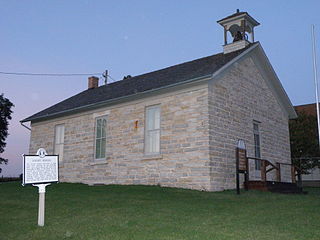
Locust School is a historic building located north of Decorah, Iowa, United States. Built in 1854, the one-room schoolhouse is composed of rubble ashlar limestone and capped with a gable roof. The lintels and window sills are also stone. A belfry with round-arch openings is located above the main entrance. The school was established just after the village of Locust was surveyed and settlement had begun. It remained in operation with all elementary grades until 1950, when it was reduced to specific grades. It was closed in 1960. The Winneshiek County Historical Society acquired the building and operates a museum in it. It was one of the first school buildings constructed in Winneshiek County. The building was listed on the National Register of Historic Places in 1978.
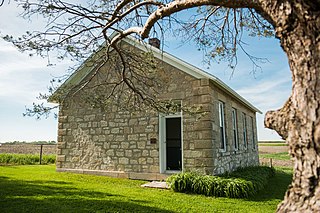
The North River Stone Schoolhouse is a historic building located north of Winterset, Iowa, United States. Built in 1874 of coursed native limestone, the one-room schoolhouse educated local students until it closed in 1945. The building features quoining on the four corners of the exterior, four windows capped with stone lintels on the east and west elevations, and an off-center doorway on the main (south) facade. From 1962 to 1973 the building was restored, and it opened as a school museum operated by the Madison County Historical Society. The building was listed on the National Register of Historic Places in 1977.

Mann School No. 2, also known as Sioux Township #2, is a historic building located west of Moorhead, Iowa, United States. Built in 1884, the building is a simple rectangular frame structure with a gable roof. Originally three bays long, an addition in the 1920s that added a cloak room and internal stairway to the basement, extended it one more bay. Located in the Loess Hills, this school differed from one-room schoolhouses on the prairie, in that it was located near the center of a cluster of families rather than at the center of four sections. Parents of the students who were educated here took responsibility for the upkeep and maintenance of the building and grounds. The building remained in use as a school until 1945 when the teacher expectantly left. Enrollment had been low to begin with so the district sent the students to a neighboring rural school and then to Moorhead. The building continued as a polling place after the school was formally closed in 1945. It was listed on the National Register of Historic Places in 2001.

Logan Center School No.5 is a historic one-room schoolhouse located south of Dickens, Iowa, United States. The property was bought for a school in 1894 for $20, and the building was constructed the following year. Enrollment here averaged between 25 and 30 students until the 1930s when it started to decline. The school was closed in 1941 when it was incorporated into the Gillett Grove Consolidated School. The building is located in the center of Logan Township. Because the township has no incorporated communities the school building has functions as a township hall, a polling place, and hosts other community events. The building was also used for worship services and religious instruction. The original privy remains in the back, but a woodshed that was part of the historical nomination has subsequently been removed. The schoolhouse and privy were listed together on the National Register of Historic Places in 2001.

Antioch School is a historic building located east of Anamosa, Iowa, United States. The frame one-room schoolhouse was constructed by local builder Edward M. Harvey in 1872. It served as a school until 1959, when it was closed. American Regionalist artist Grant Wood attended school here from 1896 to 1901. The buildings and grounds were bought by the Paint N' Palette Club who used the old school building as an art studio and gallery until 1965 when they built their present facility on the property. In 1997, the Jones County Historic Preservation Commission acquired the school building and grounds. There is also an outhouse northwest of the school building. The school and outhouse were listed together on the National Register of Historic Places in 2001.

Lincoln School, also known as the W.J. McGee Boyhood School, is a historic building located north of Farley, Iowa, United States. This is a typical Iowa one-room schoolhouse that features frame construction, rectangular shape, and a gable roof. The entryway on the front was added in the 1890s. The building is historically significant with its association with W.J. McGee, a respected inventor, geologist, anthropologist, and ethnologist. While he was largely self-taught, McGee attended school here during the four winter months from about 1858 to 1867. The building was listed on the National Register of Historic Places in 1975.

Beach School is a historic building located northwest of Mount Vernon, Iowa, United States. Because school district lines had been redrawn, students in this area were forced to attend classes in a building some distance away. Given the condition of rural roads in the late 19th century, that created a hardship for many families. From 1889 to 1891 the school district set aside funds for a new building, and Benjamin Beach donated land on his farm for the new school. Not only was his farmhouse nearby, but Beach also operated a sawmill along the creek east of the school and a gristmill across the road. The one-room schoolhouse was completed in 1892, and a bell was purchased for the building around 1901. Early drawings of the building show a small bell tower. The building was used for educational and social use until 1946, and it has subsequently been converted into a rental home. It was listed on the National Register of Historic Places in 1982.





















